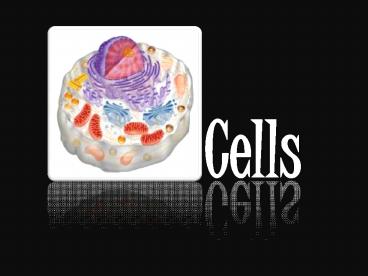Cells - PowerPoint PPT Presentation
Title: Cells
1
Cells
2
Why are cells so tiny?
- Larger cells do not function as efficiently
- The surface is the only way cells interact with
the environment - Surface-area-to-volume ratio
- As cell size increases, volume grows much more
rapidly
Cell radius (r) Surface area (4pr2) Volume ((4/3)pr3)
1 units 12.57 units2 4.189 units3
10 units 1,257 units2 4,189 units3
3
Cell Theory
- Schleiden and Schwann
- Three principles
- All living things are composed of cells
- Cells are the smallest living things
- (Functional units of the body)
- Cells come from pre-existing cells
4
Cell Types
- Prokaryotes
- Lack a nucleus and membrane bound organelles
- MUCH smaller than eukaryotes
- Bacteria
- Eukaryotes
- Have a nucleus and organelles
- Much bigger than prokaryotes
5
Cell Organelles
- Cell membrane
- Semi-permeable
- Cytoplasm cell blood
- Fluid matrix surrounding nucleus
- Surrounded by a cell membrane
- Nucleus cell brain
- Contains chromatin (loosely coiled DNA)
6
Endoplasmic reticulum
- Interconnected membranes forming canals and
flattened sac-like spaces - Functions
- Communications system
- Rough ER studded with ribosomes
- Involved in protein synthesis
- Smooth ER has no ribosomes
- Involved in synthesizing lipid
7
Ribosomes
- Composed of protein and RNA
- May be free in the cytoplasm or attached to ER
- Function
- Involved in protein synthesis
8
Golgi apparatus
- Stack of flattened membranes
- Function
- Package and transports proteins from the cell
9
Mitochondria
- Cell powerhouse
- Contains its own DNA
- Capable of self-reproduction
- Composed of 2 membranes
- Contains enzymes used in cell respiration
- Function
- Produce ATP for cellular energy (cell respiration)
10
Lysosomes
- Small sacs from the Golgi apparatus
- Contains enzymes capable of breaking down
breaking down nutrients or toxins - Function
- Digestion
11
Centriole
- Twin hollow cylinders (centrioles)
- Function
- Involved in cell division
12
Vesicles
- Tiny sacs formed by the cell membrane folding in
and pinching off - Function
- Intake or excretion of large materials
(endocytosis and exocytosis)
13
Microfilaments and Microtubules
- Tiny rods usually arranged in meshes or bundles
- Function
- Involved in cell movement
- Provides structure to the cell
14
Cillia and Flagella
- Fine, long, threadlike organelles protruding from
the cell surface - Function
- Cell movement
15
centrosome
Golgi apparatus
lysosome
vesicles
nucleus
mitochondria
flagella
smooth ER
rough ER
16
Cell Membrane
- Selectively permeable (semi-permeable)
- Allows some substances in, excludes others
- Composed of phospholipid bilayer (containing
cholesterol) and protein inclusions - Fat soluble molecules pass through the lipid part
- Water soluble molecules must move through protein
component - Pores, channels or receptors
17
(No Transcript)
18
Passive Transport
- Movement of a material into or out of a cell
without the use of energy. - Diffusion
- Osmosis
- Facilitated diffusion
- NO ENERGY REQUIRED
19
Diffusion
- The process by which molecules move down a
concentration gradient - Move from area where there is more concentration
to areas that are less concentrated - Rate limited by concentration
20
Facilitated Diffusion
- Diffusion using special carrier molecules to
allow usually non-permeable molecules to pass
through a selectively permeable membrane - Example Insulin facilitates glucose movement
- Rate of passage is
- limited by the number
- of carrier molecules
- and concentration
21
Osmosis
- The diffusion of water through a selectively
permeable membrane which may not allow dissolved
substances to pass - May result in changing volumes on either side of
the membrane - Osmotic pressure
- The amount of pressure
- needed to stop osmosis
22
Concentration Types
- Hypertonic
- A solution which has a greater concentration of
solute particles than a given cell or solution - Hypotonic
- A solution which has a lesser concentration
solute particles than a given cell or solution - Isotonic
- A solution which has an identical concentration
of solute particles to a given cell or solution
23
Filtration
- The forcing of permeable molecules through a
membrane by hydrostatic pressure - Example Blood pressure
24
Active Transport
- The movement of molecules against a concentration
gradient using cellular energy and carrier
molecules - Proton pump
- Sodium-potassium pump
ENERGY REQUIRED
25
Bulk Passage
- Endocytosis
- The inward movement of molecules through a
membrane by infolding and pinching off vesicles - Pinocytosis taking in tiny droplets of liquid
- Phagocytosis taking in solid material
- Receptor Mediated molecule bonds with receptor
protein - Exocytosis
26
Cell division
- Prokaryotes
- Binary fision
- DNA replicated in parent
- Parent divides
- Fast
- Eukaryotes
- Mitosis
- Complicated
- Lots of DNA
- Form chromosomes (compact structures, composed of
DNA and histone proteins, that can be manipulated
easily during cell division
27
Cell cycle
- Interphase
- Period Inbetween cell division
- Majority of cells life
- Cell growth
- Protein synthesis
28
Mitosis
- Cell division that Is Mighty Common
- Makes all cells EXCEPT gametes (reproductive
cells) - DNA is doubled then
- Cells divide once
29
Prophase
- Cells Prepares to divide
- Chromatin condenses into chromosomes
- Nuclear membrane disappears
30
Metaphase
- Chromosomes line up in the Middle
- Spindle Apparatus stretches from pole to pole
31
Anaphase
- Sister chromatids move Away to opposite poles
32
Telophase
- Cell Tears in two
- Nuclear membrane reforms
- Chromosomes disperse into chromatin
- Cytokinesis (cytoplasmic division) (separate
phase?) - Produces 2 identical daughter cells
33
Cell differentiation
- Process by which cells develop different
characteristics in structure and function - Differences in outcome
- Directed by cells DNA
- Determined by cells position in the body and its
chemical environment
34
(No Transcript)































